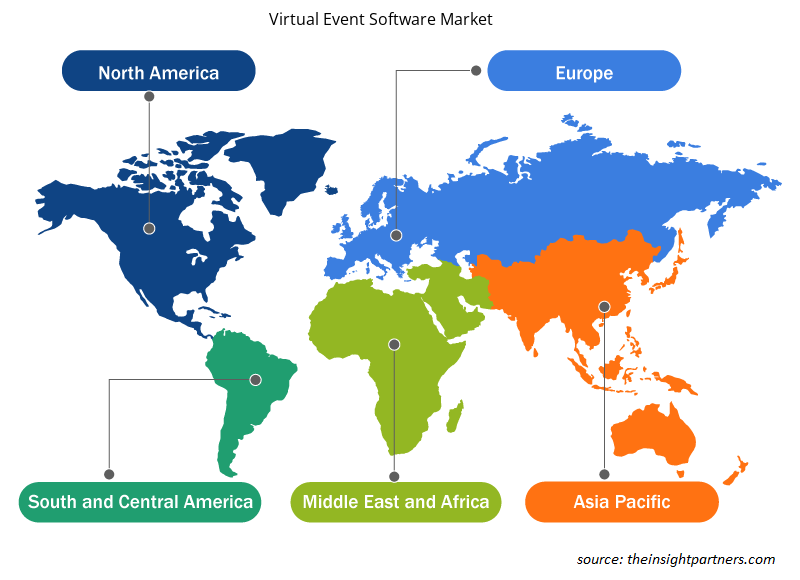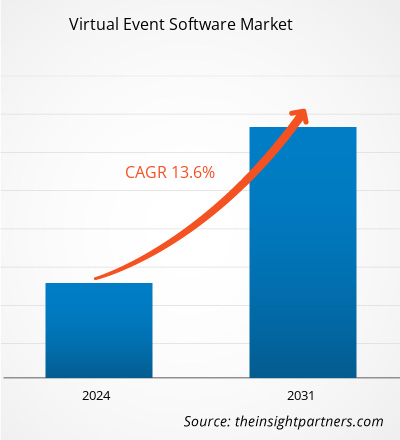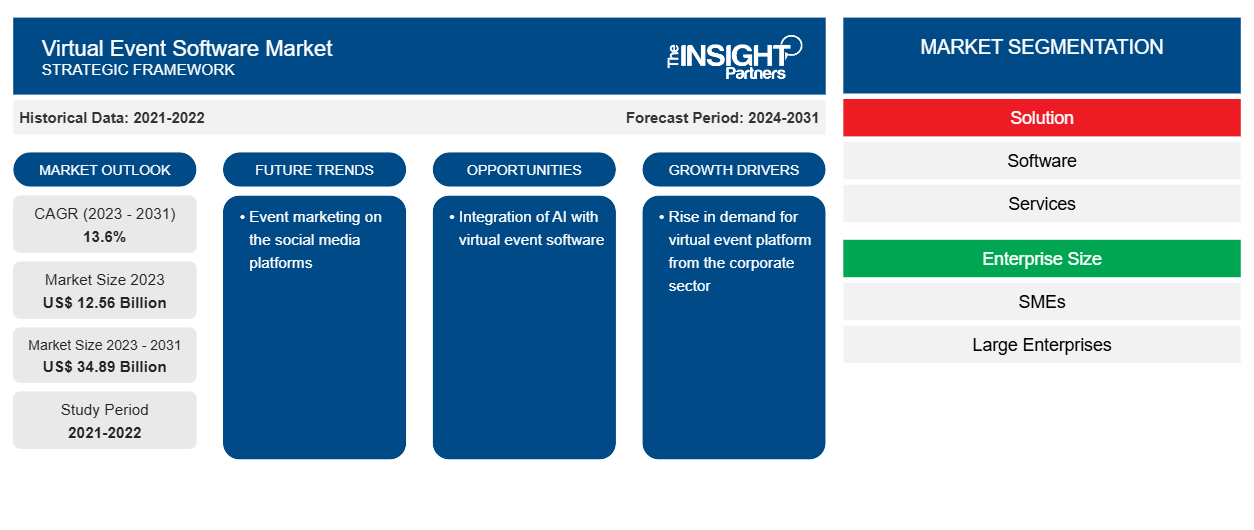Le marché des logiciels d’événements virtuels devrait atteindre 34,89 milliards de dollars d’ici 2031, contre 12,56 milliards de dollars en 2023. Le marché devrait enregistrer un TCAC de 13,6 % au cours de la période 2023-2031. La croissance des événements virtuels et l’augmentation de l’adoption de plateformes d’événements virtuels basées sur l’IA devraient rester des tendances clés du marché.
Analyse du marché des logiciels d'événements virtuels
Les logiciels d'événements virtuels gagnent du terrain en raison de facteurs tels que la pénétration croissante d'Internet, l'essor de la numérisation et l'essor de la culture du travail à domicile dans le secteur des entreprises. La capacité des logiciels d'événements virtuels à engager les participants avec diverses fonctionnalités attrayantes telles que l'interaction individuelle, les sondages de questions-réponses, les chats en direct, les émoticônes et autres stimule sa demande auprès de plusieurs utilisateurs finaux tels que les entreprises, les sociétés de gestion d'événements, les organisateurs de salons professionnels, les institutions universitaires et autres.
Aperçu du marché des logiciels d'événements virtuels
Les logiciels d'événements virtuels permettent d'organiser des événements de manière virtuelle et efficace. Ils présentent les mêmes fonctionnalités que les logiciels de gestion d'événements. La seule différence est que les logiciels de gestion d'événements incluent également la gestion de l'événement en personne. Les logiciels d'événements virtuels ont des fonctionnalités telles que la diffusion sur le Web et s'intègrent parfaitement aux logiciels de webinaires. Ils peuvent intégrer du contenu interactif tel que des discussions de groupe, des sondages de questions-réponses et du réseautage individuel . L'utilisateur peut également assister à l'événement à partir de n'importe quel appareil.
Personnalisez ce rapport en fonction de vos besoins
Vous bénéficierez d'une personnalisation gratuite de n'importe quel rapport, y compris de certaines parties de ce rapport, d'une analyse au niveau des pays, d'un pack de données Excel, ainsi que d'offres et de remises exceptionnelles pour les start-ups et les universités.
-
Obtenez les principales tendances clés du marché de ce rapport.Cet échantillon GRATUIT comprendra une analyse de données, allant des tendances du marché aux estimations et prévisions.
Moteurs et opportunités du marché des logiciels d'événements virtuels
La hausse de la demande de plateformes d'événements virtuels de la part du secteur des entreprises devrait favoriser le marché
Le secteur des entreprises connaît une popularité croissante des rassemblements virtuels, ce qui est l'un des facteurs clés à l'origine du besoin de plateformes d'événements virtuels. La vague de transformation numérique, la pandémie de COVID-19 et la culture du travail à domicile dans le secteur des entreprises ont généré le besoin d'une solution pour impliquer les employés et les parties prenantes de l'entreprise sur une seule plateforme intégrée. Les grandes entreprises ont leurs employés partout dans le monde. Pour les activités de cohésion d'équipe, l'entreprise organise divers événements où ses employés peuvent s'engager. Les événements de cohésion d'équipe aident les entreprises à créer une équipe très performante et à développer un espace pour les employés où ils peuvent interagir et en savoir plus sur les origines et les expériences diverses de chacun. Ainsi, les entreprises organisent des événements pour créer un environnement de travail et des relations sains avec les employés, ce qui alimente encore davantage leur productivité au travail.
Intégration de l'IA avec un logiciel d'événements virtuels
Les technologies intégrées à la technologie de l'IA aident l'utilisateur à détecter des modèles et des informations pour découvrir les lacunes et les opportunités qui améliorent les fonctionnalités de tout logiciel et processus. Les logiciels d'événements virtuels intégrés à l'IA peuvent aider à créer automatiquement les agendas des événements et à planifier automatiquement les événements. Il peut personnaliser les lieux et les stands virtuels. Il permet également de reproduire l'expérience en personne sur les plateformes virtuelles. Certains acteurs du marché proposent des plateformes d'événements virtuels basées sur l'IA. Par exemple, EventsX est une plateforme pilotée par l'IA pour organiser, commercialiser et héberger l'événement virtuel, hybride ou en personne parfait. Il fournit des analyses en temps réel et après l'événement qui aident les utilisateurs à comprendre les expériences des clients. L'analyse des événements les aide également à s'améliorer pour un événement futur en améliorant les expériences client personnalisées.
Analyse de segmentation du rapport sur le marché des logiciels d'événements virtuels
Les segments clés qui ont contribué à l’élaboration de l’analyse du marché des logiciels d’événements virtuels sont la solution, la taille de l’entreprise et l’utilisateur final.
- En fonction de la solution, le marché des logiciels d'événements virtuels est divisé en logiciels et services. Le segment des logiciels détenait la plus grande part du marché en 2023.
- En fonction de la taille de l'entreprise, le marché est segmenté en PME et en grandes entreprises. Les PME devraient connaître le TCAC le plus élevé au cours de la période de prévision.
- En termes d'utilisateur final, le marché est segmenté en organisateurs de salons professionnels, agences de gestion d'événements, entreprises, organisations universitaires et autres. Le segment des entreprises devrait connaître une croissance à un TCAC significatif.
Analyse des parts de marché des logiciels d'événements virtuels par zone géographique
La portée géographique du rapport sur le marché des logiciels d’événements virtuels est principalement divisée en cinq régions : Amérique du Nord, Asie-Pacifique, Europe, Moyen-Orient et Afrique, et Amérique du Sud et centrale.
La région Asie-Pacifique devrait connaître le TCAC le plus élevé au cours de la période de prévision. La numérisation croissante, la croissance du secteur des entreprises et la prolifération d'Internet dans la région sont quelques-uns des facteurs qui alimentent le marché des logiciels d'événements virtuels en Asie-Pacifique. Diverses sociétés de logiciels étendent leur présence et leurs activités dans la région, ce qui stimule encore davantage le marché. L'accent mis par le gouvernement sur la stimulation de la numérisation dans la région a encore complété la croissance du marché.
Aperçu régional du marché des logiciels d'événements virtuels
Les tendances régionales et les facteurs influençant le marché des logiciels d’événements virtuels tout au long de la période de prévision ont été expliqués en détail par les analystes d’Insight Partners. Cette section traite également des segments et de la géographie du marché des logiciels d’événements virtuels en Amérique du Nord, en Europe, en Asie-Pacifique, au Moyen-Orient et en Afrique, ainsi qu’en Amérique du Sud et en Amérique centrale.

- Obtenez les données régionales spécifiques au marché des logiciels d'événements virtuels
Portée du rapport sur le marché des logiciels d'événements virtuels
| Attribut de rapport | Détails |
|---|---|
| Taille du marché en 2023 | 12,56 milliards de dollars américains |
| Taille du marché d'ici 2031 | 34,89 milliards de dollars américains |
| Taux de croissance annuel composé mondial (2023-2031) | 13,6% |
| Données historiques | 2021-2022 |
| Période de prévision | 2024-2031 |
| Segments couverts |
Par Solution
|
| Régions et pays couverts |
Amérique du Nord
|
| Leaders du marché et profils d'entreprises clés |
|
Densité des acteurs du marché des logiciels d'événements virtuels : comprendre son impact sur la dynamique des entreprises
Le marché des logiciels d'événements virtuels connaît une croissance rapide, tirée par la demande croissante des utilisateurs finaux en raison de facteurs tels que l'évolution des préférences des consommateurs, les avancées technologiques et une plus grande sensibilisation aux avantages du produit. À mesure que la demande augmente, les entreprises élargissent leurs offres, innovent pour répondre aux besoins des consommateurs et capitalisent sur les tendances émergentes, ce qui alimente davantage la croissance du marché.
La densité des acteurs du marché fait référence à la répartition des entreprises ou des sociétés opérant sur un marché ou un secteur particulier. Elle indique le nombre de concurrents (acteurs du marché) présents sur un marché donné par rapport à sa taille ou à sa valeur marchande totale.
Les principales entreprises opérant sur le marché des logiciels d'événements virtuels sont :
- Cvent Inc.
- EventMobi (5Touch Solutions Inc.)
- Espérant
- Hubilo Technologies Inc.
- lnEvent, Inc
- Pathable, Inc.
Avis de non-responsabilité : les sociétés répertoriées ci-dessus ne sont pas classées dans un ordre particulier.

- Obtenez un aperçu des principaux acteurs du marché des logiciels d'événements virtuels
Actualités et développements récents du marché des logiciels d'événements virtuels
Le marché des logiciels d'événements virtuels est évalué en collectant des données qualitatives et quantitatives après des recherches primaires et secondaires, qui incluent d'importantes publications d'entreprise, des données d'association et des bases de données. Quelques-uns des développements du marché des logiciels d'événements virtuels sont répertoriés ci-dessous :
- Visit Maldives a lancé sa toute première plateforme de gestion d'événements virtuels. La plateforme moderne baptisée « My Virtual Maldives » a amplifié l'engagement et le réseautage du public en connectant les participants du monde entier via des événements en ligne hébergés allant des expositions virtuelles, des roadshows et des webinaires aux formations et aux événements de marketing en direct ciblant à la fois le secteur du voyage et les consommateurs. Le format basé sur le Web permet une accessibilité maximale et une navigation facile, permettant aux participants de découvrir la puissance du virtuel sur notre plateforme robuste et ses fonctionnalités, telles que le matchmaking basé sur l'IA, la génération de leads intelligents, les stands virtuels, les outils d'engagement et de réseautage hybrides, l'assistance en temps réel, les appels vidéo en direct et le chat textuel, et bien d'autres. (Source : Visit Maldives, communiqué de presse, avril 2021)
- Chati, fournisseur leader de solutions complètes d'événements virtuels et hybrides, a annoncé le lancement de sa plateforme d'événements virtuels conçue pour transformer la manière dont les entreprises, les organisations et les communautés interagissent avec le public mondial dans des environnements virtuels et hybrides. La plateforme de Chati ouvre la voie à des expériences remarquables et à des interactions précieuses pour les organisateurs d'événements en libre-service et à service complet. Son mélange unique de fonctionnalités, notamment des modèles de contenu immersifs, des espaces 3D personnalisables, la gamification, l'inscription et la billetterie aux événements et les capacités d'intégration, positionne fermement Chati comme une nouvelle référence dans le secteur des événements en ligne pour toute taille ou type d'entreprise. (Source : Chati, communiqué de presse, août 2023)
Rapport sur le marché des logiciels d'événements virtuels et livrables
Le rapport « Taille et prévisions du marché des logiciels d’événements virtuels (2021-2031) » fournit une analyse détaillée du marché couvrant les domaines ci-dessous :
- Taille et prévisions du marché des logiciels d'événements virtuels aux niveaux mondial, régional et national pour tous les segments de marché clés couverts par le champ d'application
- tendances du marché des logiciels d'événements virtuels ainsi que la dynamique du marché, comme les facteurs moteurs, les contraintes et les opportunités clés
- Analyse détaillée des cinq forces de PEST/Porter et SWOT
- analyse du marché des logiciels d'événements virtuels couvrant les principales tendances du marché, le cadre mondial et régional, les principaux acteurs, les réglementations et les développements récents du marché
- Analyse du paysage industriel et de la concurrence couvrant la concentration du marché, l'analyse de la carte thermique, les principaux acteurs et les développements récents du marché des logiciels d'événements virtuels
- Profils d'entreprise détaillés
- Analyse historique (2 ans), année de base, prévision (7 ans) avec TCAC
- Analyse PEST et SWOT
- Taille du marché Valeur / Volume - Mondial, Régional, Pays
- Industrie et paysage concurrentiel
- Ensemble de données Excel
Rapports récents
Rapports connexes
Témoignages
Raison d'acheter
- Prise de décision éclairée
- Compréhension de la dynamique du marché
- Analyse concurrentielle
- Connaissances clients
- Prévisions de marché
- Atténuation des risques
- Planification stratégique
- Justification des investissements
- Identification des marchés émergents
- Amélioration des stratégies marketing
- Amélioration de l'efficacité opérationnelle
- Alignement sur les tendances réglementaires























 Obtenez un échantillon gratuit pour - Marché des logiciels d'événements virtuels
Obtenez un échantillon gratuit pour - Marché des logiciels d'événements virtuels